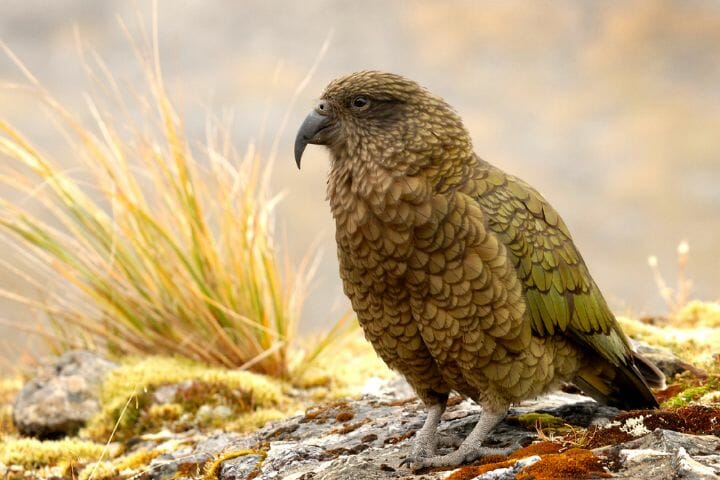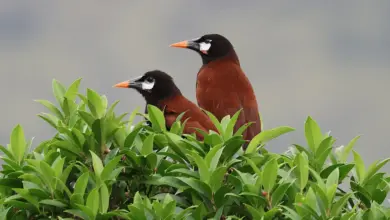Kea Bird Facts: Meet The World’s Smartest Bird!
Read all about how the Kea bird, famously known as the “clown of the alps,” is among the most intelligent creatures on the planet.
The Kea is a unique and intelligent bird species found in the alpine regions of New Zealand’s South Island.
Often referred to as the “clown of the mountains,” this unusual parrot has an interesting conservation story, and it is the only alpine parrot in the world.
Known for their intelligence, these remarkable birds have been tested on various intelligence tests. They are said to possess a higher level of problem-solving skills than even four-year-old children!
They are also known for their resourcefulness; they often seek food from human or animal sources with great skill.
Unfortunately, this behavior often finds them in trouble with the farmers and tourists in the ski fields and coastal regions of the South Island.

Kea Bird Facts
| Common name | Kea |
| Scientific name | Nestor notabilis |
| Lifespan | Up to 50 years |
| Weight | 750g to 1kg |
| Diet | Omnivorous: plants, invertebrates, small birds, stock animals (such as sheep), and carrion |
| Distribution | Alpine regions of South Island New Zealand |
| Population size | 3000-7000 |
| Conservation status | Threatened – Nationally Endangered |
The Most Intelligent Bird Species?
Kea birds are incredibly intelligent, possessing a level of animal intelligence that is comparable to great apes such as chimpanzees.
A recent study published in Nature Communications revealed the incredible capability of Kea birds to predict the likelihood of an event occurring, a trait previously only seen in humans and other primates.
Even more impressive, Keas have shown an impressive ability on intelligence tests, depicting their capacity for problem-solving and analytical thinking.
Along with this, Keas have been observed to display signs of domain-general intelligence; they can combine two separate sources of information to create a single judgment.
It is no surprise, then, that hunters, farmers, and hikers often encounter these smart birds trying to figure out how to access food or resources by removing rubbish bin lids or opening sliding doors.
One bird even understood the concept of bartering: if it brought firewood to a hiking hut each day and knocked on the door, it would get food in return!

A History of Human Conflict
Humans and Keas have a long and turbulent history. For many years, Keas were persecuted by humans due to their habit of preying on livestock and agricultural crops.
Starting in the late 1800s and lasting until 1970, the New Zealand government collaborated with local councils and runholders to pay a bounty for kea. Each beak turned in would pay out.
The policy was intended to motivate hunters to kill kea only on farms and council areas that paid the bounty.
However, some hunters targeted them even within national parks where they were officially protected.
As a consequence of this program, more than 150,000 keas were killed over the course of one hundred years before the bounty was finally lifted in 1970.
The conflict between humans and kea has not been contained solely within the realm of hunting policies.
There have also been numerous accounts of property damage caused by these birds.

Alpine Climbers
Kea are the world’s only alpine parrot, inhabiting the higher altitudes of New Zealand’s mountainous regions.
These birds are well-adapted to their harsh environment, thriving in areas where other organisms cannot survive.
Unlike some parrots, they are omnivorous, consuming both plant- and animal-based foods. This allows them to find sustenance in areas where resources are often scarce and hard to come by.
Keas have the ability to climb steep rocky surfaces, which helps them access food sources located high up amongst cliffs or on top of mountain peaks.
Kea Size
The kea birds is a medium-sized parrot, measuring roughly 48 centimeters (about 19 inches) in length from the top of its head to the tip of its tail feathers.
It has a short, sharp beak, which is grey-brown on top and yellow underneath. Its feathers are olive green with vibrant orange patches beneath its wings. Its legs are grey, and the soles of its feet yellow.
The Kea birds has a very powerful beak, which it uses for breaking open hard food sources such as pine cones and walnuts.
This strength also allows them to remove bark from trees to expose food sources such as grubs and insects hiding beneath.
They have a wingspan of up to 52 cm (about 20 inches), enabling them to make swift aerial maneuvers when flying at speeds of up to 60 kilometers per hour (37 mph).
Kea Bird Diet
The diet of the kea birds mainly consists of fruits, flowers, leaves, roots, shoots, and buds. It also feeds on animal matter, such as insects and larvae found in tree bark or near rivers and streams.
They are known to be scavengers, too, picking at the human litter, such as food scraps left behind by people in picnic areas.
In addition, keas enjoy eating carrion and are also known to raid bird’s nests of other species.

Kea Breeding
Kea mating occurs during winter, with peak activity occurring from June to August.
Pairs form during the breeding season and remain together until the end, although male-female bonds are not usually monogamous.
During courtship, males will exhibit an aerial display in which they fly over the female and make loud calls.
Nests are usually on the ground, between rock crevices, or in burrows dug under tree roots. Tunnels to the burrows can go as far as 1-6 meters, and the nest is padded with moss and ferns.
Once eggs have been laid by the female, she incubates them for around 25 days while receiving food from her mate throughout this period.
When the chicks hatch, they remain at their nesting site until they are eight weeks old.
Mortality rates among young kea can be quite high; less than 40% of chicks survive their first year due to predation from mammalian species such as stoats, cats, and rats.
It has been estimated that around 10% of the local kea population may live up to 20 years old or more; indeed, some captive keas have been recorded living up to 50 years old!

Threats to the Kea Population
Unfortunately, these beautiful birds are facing significant threats to their population.
- Lead poisoning is a major cause of death among Keas, and it mostly comes from building materials such as roofs.
- Invasive predatory mammals have also posed a major threat to the Kea population over generations. These mammals include rats, mustelids like stoats, and possums which were introduced by Europeans centuries ago and pose a great danger to the nests and eggs of these birds due to their location on or near ground level.
- The 1080 pesticide has been used as a control method for these predators. Keas, known for their curiosity, have fallen victim to the very poison which is trying to save them.
- Human interference, such as poaching, also impacts the Kea population. Keas are known to interact with visitors to the area and are at great danger from dietary disruptions when fed ‘people food.’
Conservation
Kea conservation is a major focus in New Zealand. The kea is classified as Nationally Endangered in the New Zealand Threat Classification System, with their population estimated to be between 3,000 and 7,000 individuals.
The Kea Conservation Trust (KCT) was founded in 2006 with the mission of protecting kea populations. It also works closely with government organizations such as DOC (Department of Conservation) to help protect the species.
In 2017, a “Kea Database” was launched, allowing observations about keas to be recorded into an online database for research purposes.
NZ Transport Agency has installed signs around roads where a lot of traffic kills occur to raise awareness about slowing down if necessary when these birds are spotted nearby.
Overall, there are many initiatives underway that seek to protect this species from extinction, such as habitat restoration work and predator control programs.

Kea Vs. Kaka Vs. Kakapo Differences
Kea, Kaka, and Kakapo are all native New Zealand birds within the same genus (Nestor). Still, they are each distinct species with different natural behaviors.
- The Kea is the world’s only alpine parrot known for its intelligence and playfulness.
- The Kaka is a large brown and grey parrot with a patch of red feathers on its upper tail covers.
- The Kakapo is the world’s only flightless parrot; it resembles an owl in its appearance.
Frequently Asked Questions
What makes a kea special?
Which are the two most intelligent birds?
The African Grey Parrot is famous for being able to solve problems, learn over 200 words, and even mimic human speech.
Are keas smarter than crows?
They can solve complex puzzles and even pass intelligence tests designed for a four-year-old human child.
What’s the smartest bird that talks?
Like other parrots, these birds become attached easily to one person or bird and can outsmart predators by using their mimicry.
Wrap Up
The Kea Birds is an amazing and beautiful bird that has adapted to its environment to survive. With their intelligence, playful nature, and powerful curved beak, they are a truly remarkable species of parrot.
Like much of New Zealand’s endemic species, Kea populations are at risk of extinction due to introduced pest species.
It is up to us to protect these intelligent birds and the unique habitat they inhabit.
With our help, the South Island’s alpine regions can remain a home for these clever birds for future generations to appreciate.




